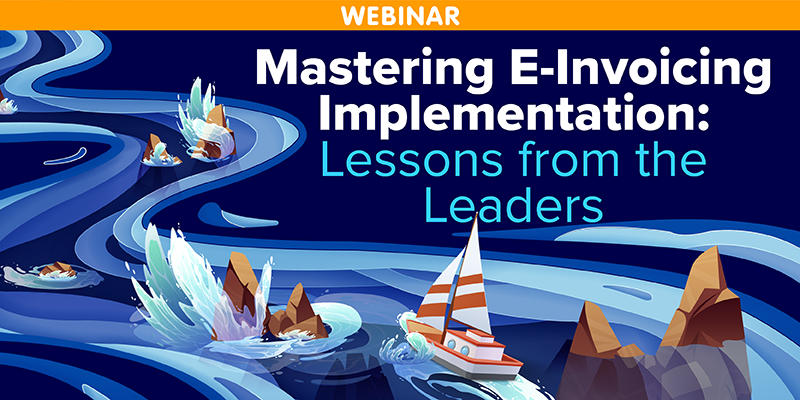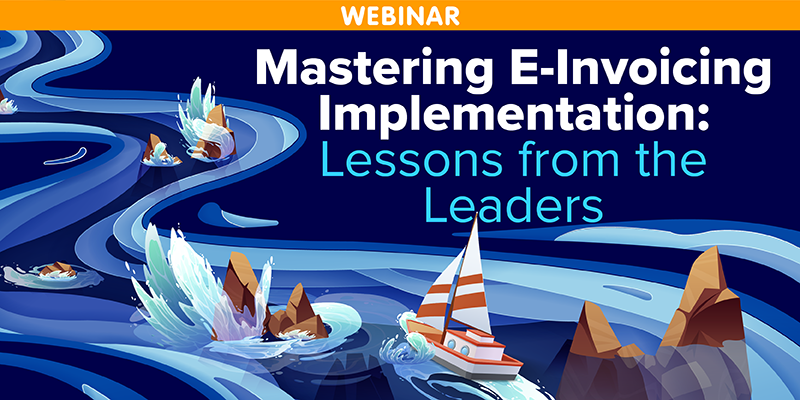Mastering E-Invoicing Implementation: Lessons from the Leaders
Description
e-Invoicing is not only a more efficient and secure way of doing business, it is required and mandated in a growing number of countries. And as more projects are rolled out, the more we realize: implementing e-invoicing is not always smooth sailing.
We've identified at least 9 mistakes companies continue to make as they implement e-invoicing. Join us for a webinar and discover the most common mistakes, and how to overcome them.
Based on survey findings, sharedserviceslink and Avalara will share, for the first time, key insights that may influence your strategic thinking. We will explore:
- The most common challenges of e-invoicing implementation projects
- The obvious and not-so-obvious mistakes in early stages of implementation
- The reasons e-invoicing programs are often more time-consuming than expected
- To what extent companies are employing extra resources (external advisors, extra staff, etc.) to complete the implementation
- What to know about integration with other systems to avoid common pitfalls
While most of our survey respondents have seen significant benefits from their e-invoicing implementation, there are many issues that most companies fail to plan for.
What was discussed on the webinar:
The landscape of invoicing is undergoing a significant transformation globally, with electronic invoicing (E-invoicing) emerging as the clear direction for businesses across various sectors. In a recent webinar, experts discussed the evolution of E-invoicing, challenges faced by organizations, and strategies to navigate this journey effectively.
E-Invoicing: A Global Imperative
The webinar highlighted that E-invoicing has become a global issue, with tax authorities worldwide embracing it as the standard approach. Previously, invoicing may have been managed locally or outsourced, but now it's a strategic concern for headquarters. Mandates for E-invoicing, initially focused on business-to-government transactions, have expanded to include business-to-business interactions, with additional requirements like QR codes and unique numbers.
ERP Challenges and Solutions
Survey data revealed that while many organizations believe their Enterprise Resource Planning (ERP) systems can manage invoicing processes compliantly, a significant portion still have doubts or recognize the need for third-party solutions. The complexity arises from variations in regulations, formats, and certification requirements across different jurisdictions.
To address these challenges, organizations are increasingly leveraging specialized invoicing technology alongside their ERP systems. These solutions provide connectivity, compliance, and functionality that ERPs may lack, ensuring seamless integration and compliance with evolving mandates.
Time and Resource Considerations
Implementing E-invoicing projects often proves more time-consuming and costly than anticipated. Challenges include integration with existing systems, data cleanliness, and compliance with tax policies. Additional resources, including external advisors and project management specialists, are essential for successful implementation.
Benefits of E-Invoicing
Despite the challenges, organizations are reaping numerous benefits from E-invoicing. These include time savings, improved efficiency, process control, enhanced visibility, cost savings, and better relationships with suppliers. Moreover, E-invoicing compels businesses to address data quality issues, leading to more accurate financial processes and compliance.
Key Strategies for Success
The webinar concluded with key strategies for organizations embarking on their E-invoicing journey:
- Strategic Investment: View E-invoicing as a strategic investment rather than a tactical fix, involving stakeholders from various departments to understand its impacts and benefits.
- Comprehensive Planning: Develop comprehensive roadmaps detailing timelines, resource requirements, and integration strategies, considering the broader business calendar to avoid disruptions.
- Expert Support: Engage external advisors and specialists to navigate complex regulations, ensure data compliance, and streamline integration with existing systems.
- Education and Awareness: Educate stakeholders across the organization about the implications and benefits of E-invoicing, fostering a culture of positivity and understanding.
- Data Quality Focus: Prioritize data quality initiatives to ensure clean, granular data that supports compliance and unlocks the full potential of E-invoicing benefits.
Embracing the Future of Invoicing
As E-invoicing continues to evolve globally, organizations must approach it strategically, recognizing its transformative potential beyond mere compliance. By investing in the right technology, resources, and processes, businesses can navigate the E-invoicing journey successfully, unlocking efficiency gains, cost savings, and enhanced compliance in the process.



